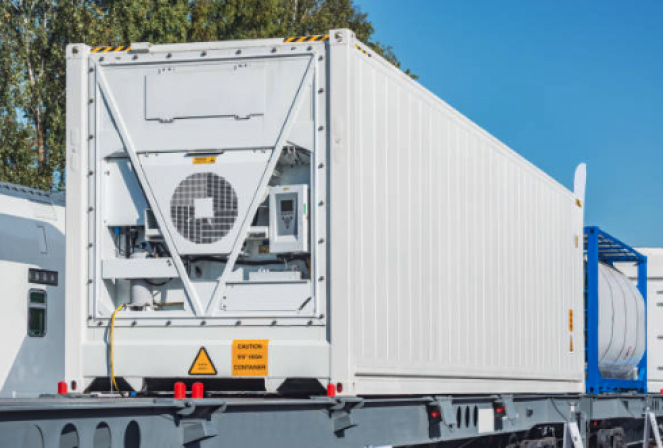How do goods get from one side of the planet to the other? Freight logistics keeps everything going, all across the globe. The worldwide supply chain involves air, road, sea, and rail transportation. When two or more of these methods of transportation are used, we call this intermodal transportation. These four modes of transportation also intersect in intermodal trucking. So what is intermodal trucking?
Let’s take a look at the definition of intermodal trucking, how intermodal trucking differs from other types of trucking, the advantages of intermodal trucking, and how to find intermodal trucking jobs. Keep reading to learn everything about intermodal driving.
What is intermodal trucking?
Intermodal trucking is the trucking portion of an intermodal shipment process. It is also referred to as drayage. Intermodal trucking typically handles the first and last mile of the journey, and the middle portion is handled by sea, air, and/or rail.
For example, if a shipper needs to move a load from the manufacturing facility in Louisiana, to a distribution center in New York, the shipper will compare rates and learn that it is cheapest to ship the freight in a container on a train. But how does the freight get from the manufacturing facility to the railway terminal in Louisiana, and from the railway terminal in New York to the distribution center? Intermodal trucking is the solution. Intermodal trucking is a crucial component of the supply chain.
In another example of intermodal trucking, a container of pants is traveling from China to a distribution center on the West Coast. The container is transported on a ship to a port on the West Coast. Once it’s at the port, the container is moved onto a flatbed truck and driven to the destination. The final portion of the delivery is drayage, or intermodal trucking.
How is intermodal different from other types of trucking?
Within all of the various types of trucking, intermodal trucking is most different from over-the-road (OTR) or long-haul trucking. In comparison to OTR trucking, intermodal trucking involves much shorter trips. Intermodal trucking consists of short hauls between railyards or shipyards and warehouses, so there is no long distance hauling involved. In OTR trucking, loads may be driven coast to coast, so drivers are on the road for weeks at a time. Intermodal trucking is also much more fuel efficient and green than OTR trucking. OTR trucking contributes to pollution levels and highway congestion. Intermodal trucking is a more environmentally friendly method of transportation because it combines fuel efficient rail travel with logistically necessary trucking.
Advantages of Intermodal Trucking
Now that you have had intermodal trucking explained, let’s take a look at some of the key advantages.
Cost Savings
Because railroads and ocean liners are great methods for moving large volumes of cargo at relatively inexpensive rates, intermodal freight transportation and trucking saves carriers and shippers a lot of money.
Energy Efficient
One of the main reasons why sea and rail travel are relatively inexpensive is due to the fuel efficiency of these two methods. In comparison to OTR trucking, moving freight with intermodal trucking reduces highway congestion and pollution. Additionally, intermodal containers are versatile and reusable, which makes this method of transportation relatively eco friendly.
Scheduling is Firm
WIth OTR trucking, appointments for pickup and drop off are not firm. In contrast, with intermodal trucking, the appointments are rock solid. Many railroads provide detailed tracking information and are well-organized with clear and non-negotiable train schedules. This clarity eliminates a lot of guesswork and wasted time.
Wear and Tear of Equipment is Reduced
Because each trip is a short distance, intermodal trucking companies and owner operators can avoid the equipment wear and tear that is common with OTR trucking.
Cargo is Safe and Secure
All of the cargo that is transported via intermodal trucking is stored in a standardized container. The container is moved between modes of transportation and onto trucks without ever opening the container. Once the cargo is packed in the container, no one handles the freight. The lack of handling increases the safety and security of the cargo. Additionally, intermodal trucking includes a greater amount of visibility to the cargo than OTR trucking so the container is significantly more secure.
Drivers Have a Great Road-Home Balance
Intermodal truck drivers make short hauls, can choose their own lanes, have flexible scheduling opportunities, and can spend a great deal of time at home without sacrificing pay. To learn more about what it is like to be an intermodal truck driver, read this blog.
Companies Hiring for Intermodal Drivers
QFS Transportation is one of the best intermodal trucking companies offering intermodal trucking services throughout the United States, and we are hiring for intermodal drivers. Our corporate headquarters is based in Indiana, but most of our truck drivers operate in other areas throughout the country. If you are interested in intermodal trucking and want to benefit from best-in-class support and advanced technology that makes your job easier, become an intermodal truck driver with QFS Transportation. Contact QFS Transportation today!


